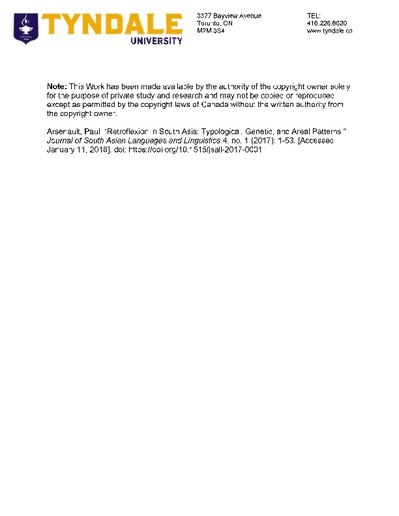| dc.rights.license | Attribution-NonCommercial-NoDerivatives 4.0 International License | en_US |
| dc.contributor.author | Arsenault, Paul | |
| dc.date.accessioned | 2021-09-03T14:40:17Z | |
| dc.date.available | 2021-09-03T14:40:17Z | |
| dc.date.copyright | 2017 | |
| dc.date.issued | 2017 | |
| dc.identifier.citation | Arsenault, Paul. “Retroflexion in South Asia: Typological, Genetic, and Areal Patterns.” Journal of South Asian Languages and Linguistics 4, no. 1 (2017): 1-53. [Accessed January 11, 2018]. doi: https://doi.org/10.1515/jsall-2017-0001 | en_US |
| dc.identifier.issn | 2196-078X | en_US |
| dc.identifier.uri | https://digitalcollections.tyndale.ca/handle/20.500.12730/963 | |
| dc.description | Includes bibliographical references | en_US |
| dc.description.abstract | Retroflexion in South Asia has been the subject of at least two previous typological studies: Ramanujan and Masica (1969) and Tikkanen (1999). Despite their many virtues, these studies are limited by the size of their data samples, their dependence on qualitative data without quantitative analysis, and their use of hand-drawn maps. This paper presents the results of an entirely new survey of retroflexion in South Asia - one that incorporates a larger language sample, quantitative analysis, and computer-generated maps. The study focuses on the genetic and geographic distribution of various retroflex subsystems, including retroflex obstruents, nasals, liquids, approximants and vowels. While it is possible to establish broad statistical correlations between specific types of contrast and individual language families (or sub-families), the study finds that the distribution of most retroflex systems is more geographic in nature than genetic. Thus, while retroflexion is characteristic of South Asia as a whole, each type of retroflex system tends to cut across genetic lines, marking out its own space within the broader linguistic area. | en_US |
| dc.format.mimetype | application/pdf/ua | en_US |
| dc.language.iso | en | en_US |
| dc.publisher | De Gruyter Mouton | en_US |
| dc.rights | Copyright, De Gruyter Mouton. All rights reserved. | en_US |
| dc.rights.uri | https://creativecommons.org/licenses/by-nc-nd/4.0/ | en_US |
| dc.subject.lcsh | Phonetics | en_US |
| dc.subject.lcsh | Typology (Linguistics) | en_US |
| dc.subject.lcsh | Areal linguistics | en_US |
| dc.title | Retroflexion in South Asia: Typological, Genetic, and Areal Patterns | en_US |
| dc.type | Article | en_US |
| dc.contributor.affiliation | Tyndale University | en_US |
| dc.contributor.department | Department of Linguistics | en_US |
| dc.contributor.repository | Tyndale University, J. William Horsey Library, 3377 Bayview Ave., Toronto, ON, M2M 3S4, Canada. Contact: repository@tyndale.ca | en_US |
| dc.identifier.doi | https://doi.org/10.1515/jsall-2017-0001 | en_US |
| dc.identifier.issue | 1 | en_US |
| dc.identifier.journal | Journal of South Asian Languages and Linguistics | en_US |
| dc.identifier.volume | 4 | en_US |
| dc.publisher.place | Berlin, Germany | en_US |
| dc.rights.holder | De Gruyter Mouton, Genthiner Straße 13, 10785 Berlin / Germany, E-Mail: service@degruyter.com | en_US |
| dc.subject.keyword | Phonology | en_US |
| dc.subject.keyword | Retroflex—South Asia | en_US |
| dc.subject.keyword | Typology | en_US |
| dc.subject.keyword | Areal feature | en_US |
| dc.description.chapterpage | 1-53 | en_US |
| dc.description.note | This is a pre-publication draft. | en_US |
| dc.description.note | For AODA accommodation, including help with reading this content, please contact repository@tyndale.ca | en_US |
| dc.description.version | Pre-publication version | en_US |


